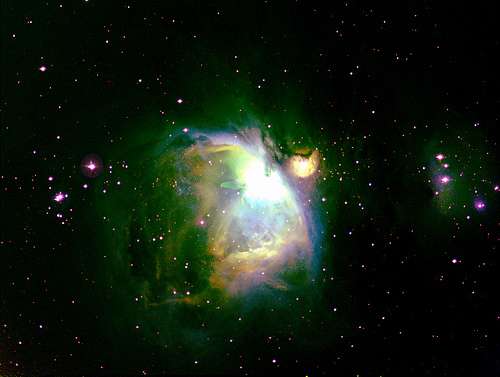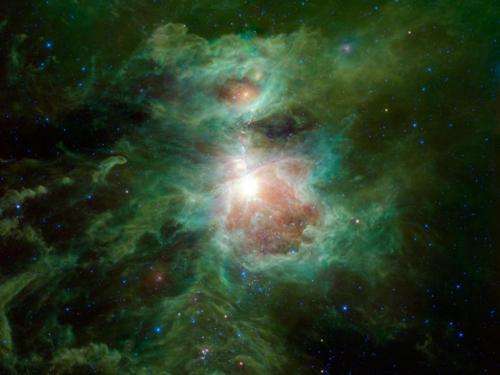M 42 in Orion using the ‘Hubble “Palette.’ Credit: Images by Gary Gonnella, image editing by Paul M. Hutchinson.
The enormous cloud of dust and gas that makes up the Orion Nebula is featured in this beautiful astrophoto. This image was a joint effort, with images taken by Gary Gonnella – a regular on our Virtual Star Parties – and image editing by Paul Hutchinson. Paul used the "Hubble Palette" – named for the Hubble Space Telescope and its capability of imaging in very narrow wavelengths of light using various filters. This enables astrophotographs to reveal details of objects in space that can't be seen by the human eye. Here, the filters used produced different colors: were Hydrogen Alpha=Green, S=Red, O=Blue. Paul said he combined two exposures, a 1 minute and 10 second exposure, to reduce the blow-out in the bright center of the nebula. The results are striking!
Compare this great image to another image of the Orion Nebula, recently taken by the WISE telescope (Wide-field Infrared Survey Explorer), below. Colors in this image represents specific infrared wavelengths. Blue represents light emitted at 3.4-micron wavelengths and cyan (blue-green) represents 4.6 microns, both of which come mainly from hot stars. Relatively cooler objects, such as the dust of the nebulae, appear green and red. Green represents 12-micron light and red represents 22-micron light.
The Orion Nebula as seen by the WISE telescope. Credit: NASA/JPL-Caltech/UCLA
The Orion nebula is part of the larger Orion molecular cloud complex, which also includes the Flame nebula. This region is actively making new stars.
Source: Universe Today

























